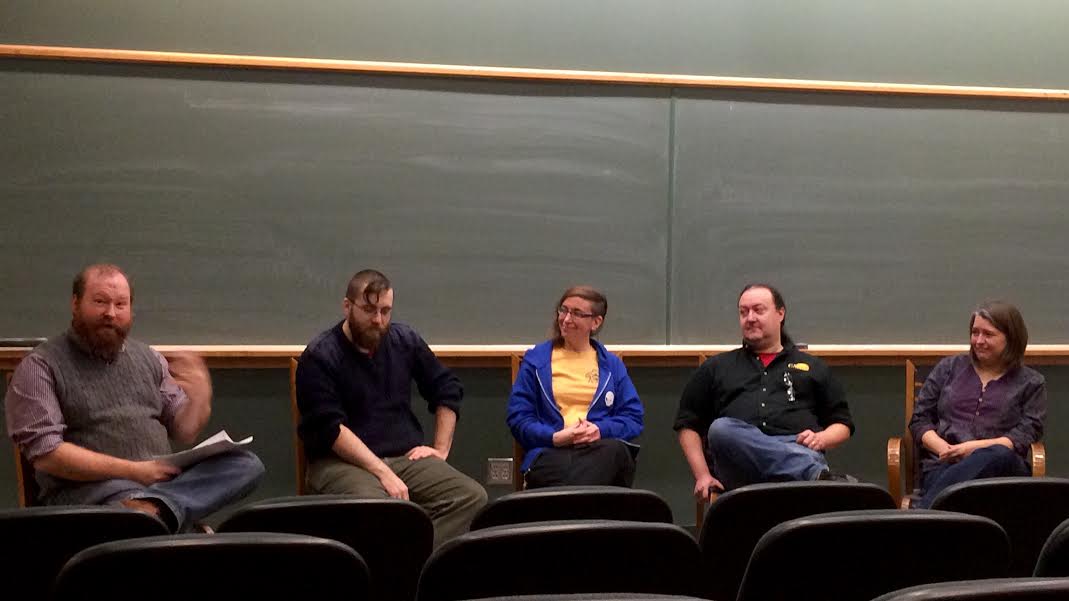When you play games, do you wonder what goes into designing them, making them, marketing them? Do you wonder how the place of women in the game industry has or has not changed over the years? Do you wonder how you might break into the industry and what kind of roles are available and viable? Dr. Jennifer Spohrer (Bryn Mawr College), Nicole Kline and Anthony Amato (Cardboard Fortress Games), and Ron Magin (Mayfair Games) discuss the aspects of the gaming industry and the creative process behind designing games. The even was organized and moderated by Patrick Crowley, Rare Books Catalog Librarian at Bryn Mawr College Library. The panel started with each person introducing themselves and their career paths.
The panel started with each person introducing themselves and their career paths.
Jennifer Spohrer explained how she got a job for a game company that didn’t exist before she started college. One day, she was helping a friend open a deli by drawing images for the menu. Someone from the game company saw her art and recruited her to do graphic design. She started off as a 3D graphic design intern and gradually worked up to a technical writer position (writing game manuals), learning 2D graphic design and coding on the job. Later she decided she wanted to go to graduate school, then she got a teaching job at Bryn Mawr. Because of her technical background, she switched to leading the Educational Technology department at Bryn Mawr.
Ron Magin (who showed up wearing Catan socks) always loved playing games as a kid. He stumbled into a gaming center one day and a librarian gave him a job in the science fiction section which happened to have a good game selection. Game retail lead to distribution, which lead to layout and game publishing, sales, and marketing. Magin found his calling in game publishing. If he could go back in time, he would have liked to focus more on self publishing games instead of selling others’ games. He also does a lot of game cataloging and works closely with game designers as a game editor.
Nicole Kline and Anthony Amato also grew up loving games. In 2008, Kline attended a Penny Arcade Game Expo. She liked it so much she started writing online game reviews. Then she started writing for games and joined the Philly Game Forge. Kline and Amato met at a game expo, started dating, and recently made a game (Resistor) together in under 12 hours. Amato did the art and illustration. Both have full time jobs and do game design on the side, but eventually they would like to switch full time to gaming.
Q & A
============================
What role does writing have in game design?
The panelists agreed that it’s important to get different perspectives on games to write game manuals. Their target audience is typically White men ages 16-35 who do not like to read. Spohrer pointed out that the web, film, and YouTube tutorials have greatly altered writing for games. Game instructions are traditionally spread orally by one “Shaman” who has read the manual. Now with video tutorials, written manuals are not as important.
Video Game vs. Analog Game
Video games require the player to press buttons, so programmers can make the instruction manual interactive. Manuals usually try to contain as many graphical instructions as possible to cut down the wording. All panelists agreed that digital board games can only be supplemental to analog games. Amato pointed out that print manuals are for a certain social experience away from technology. Crowley added that game materials and physical objects create a focal point around where a community gathers. Ron recalled a person asking him if he thought board games would ever die out due to video games. Ron’s response was that no, board games would not die. Video games are usually a solo experience, which is not the same as board games and gaming as a social activity. Analog games create a safe space for people to get absorbed into the character of the game, even if it does not reflect a person’s true personality.
Do game designers read the reviews?
No. There is an online gaming review forum called BoardGameGeek.com, but the people have a specific taste. There’s a game for everyone, so reviews don’t matter.
Is it still possible to learn on the job?
Yes, though there is some luck and internal drive you need. Amato said he would have benefitted from graphic design skills offered at an arts school or college. Magin also did not attend college. He suggests that you must constantly reinvent yourself — “to be the most flexible tool in the tool box” and always voice your opinions of how to solve problems.
What comes first: Rules or Theme?
Rules. It is much harder to apply game mechanics to a theme than the reverse. Themes are so easily thought of and so easily trashed.
